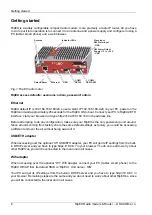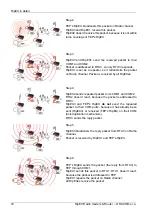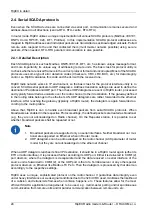
Solution 2.
Use a single repeater. (Whenever network layout
allows that.)
1
2
Good
CEN
RPT1
REM
2. Parallel repeaters
Improperly designed network:
Centre
Repeater1
Remote1
1
2
1
2
Remote2
Repeater2
X
COLLISION!
GOOD
WRONG
1
2
1
2
CEN
CEN
RPT1
RPT1
REM1
REM1
1
2
1
2
REM2
REM2
RPT2
RPT2
2
- RipEX REM1 is within the range
of two repeaters (RPT1 and RPT2).
The repeaters receive a packet (1)
from the centre (CEN) and repeat
it at the same time (2) causing a
collision at REM1.
Well-designed network:
- A remote is only in the range of a
single
repeater
(REM1-RPT1,
REM2-RPT2).
There is always only one repeater
where the centre and remote cov-
erage areas overlap.
2.3. Router mode
RipEX works as a standard IP router with two interfaces (radio and ethernet) and two COM port devices.
There is a sophisticated anti-collision protocol on the radio channel, which checks and verifies every
single packet. Being an IP router, each unit can simultaneously work as a store-and-forward repeater
and deliver packets to the connected equipment.
The router mode is suitable for all uses. In contrast to the bridge mode, a packet reception is confirmed
over the radio channel even in very simple polling type applications, and if necessary the packet is re-
transmitted.
Note
Broadcasts (Limited or Direct) and Multicasts on Ethernet are not supported in Router mode.
Only broadcasts in serial SCADA protocols are transferred according their settings.
You can see an instructional video explaining the Router mode functionality here: http://www.ra-
com.eu/ripex-router-mode
19
© RACOM s.r.o. – RipEX Radio modem & Router
RipEX in detail
Содержание RipEX 1.6.0
Страница 2: ......
















































